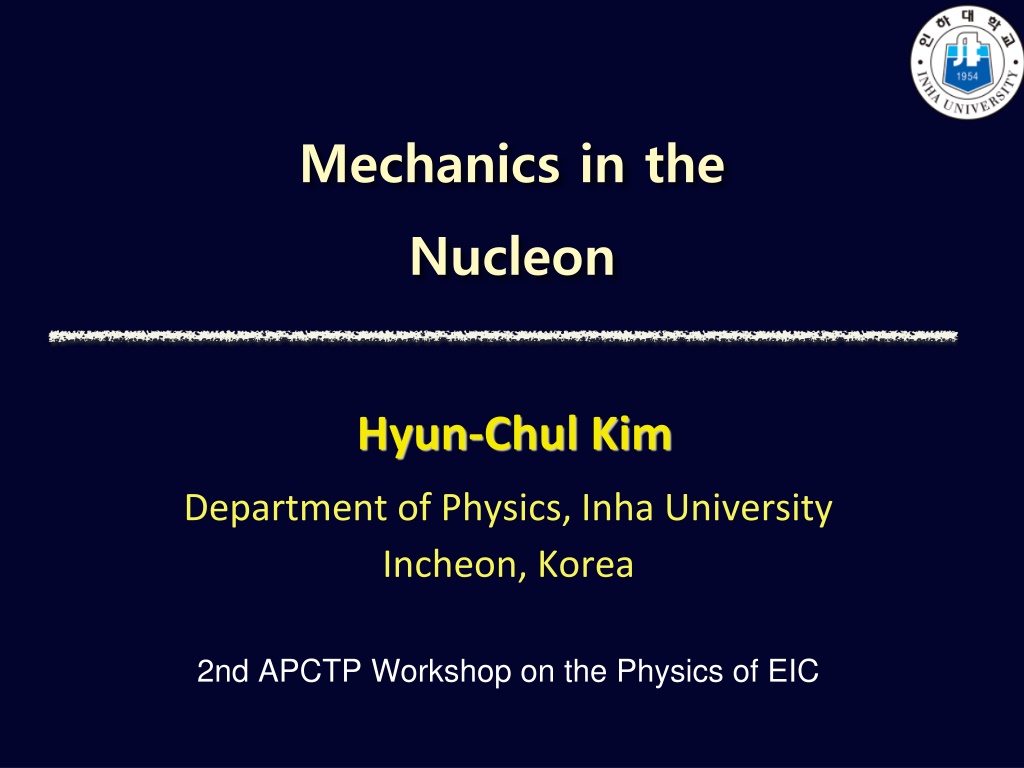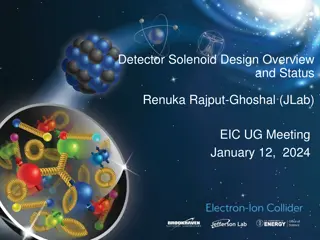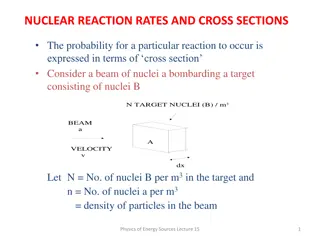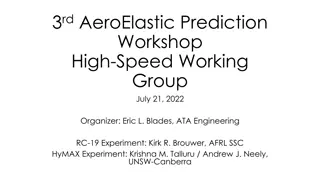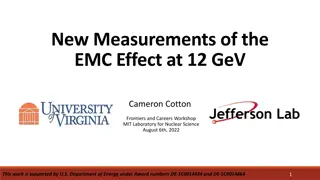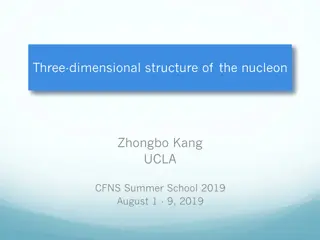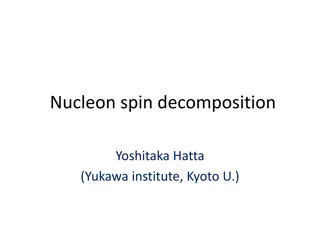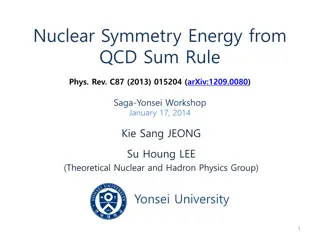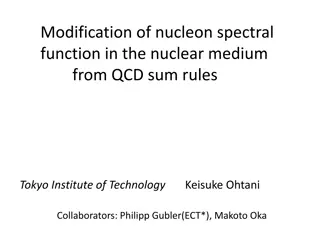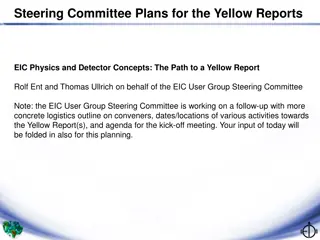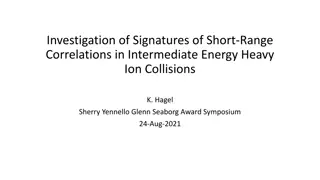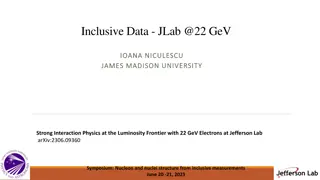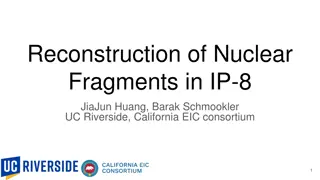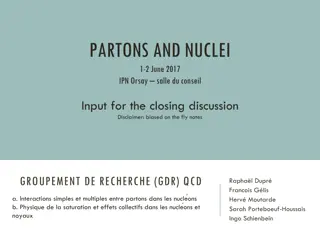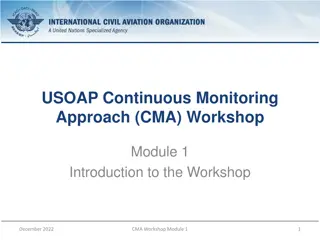Understanding Nucleon Structure: Insights from EIC Workshop
Exploring the mechanics of nucleons and the physics goals of the Electron-Ion Collider (EIC), this content delves into the origin of nucleon mass and spin, emergent properties of dense gluon systems, and energy-momentum tensor in QCD. It discusses the role of gluons in understanding nucleon structure, generalized parton distributions, form factors, and modern approaches to studying nucleon tomography. The content also highlights the need to probe tensor and gravitational form factors for a comprehensive understanding of nucleon properties.
Download Presentation

Please find below an Image/Link to download the presentation.
The content on the website is provided AS IS for your information and personal use only. It may not be sold, licensed, or shared on other websites without obtaining consent from the author. Download presentation by click this link. If you encounter any issues during the download, it is possible that the publisher has removed the file from their server.
E N D
Presentation Transcript
Mechanics in the Nucleon Hyun-Chul Kim Department of Physics, Inha University Incheon, Korea 2nd APCTP Workshop on the Physics of EIC
Physics Goals at EIC How does the mass of the nucleon arise? How does the spin of the nucleon arise? What are the emergent properties of dense systems of gluons? Final CDR for EIC
Physics Goals at EIC Energy Momentum Tensor in QCD Decompositions of the Nucleon Mass and Spin X.D. Ji (1996) When the parton spins and orbital angular momentum are decomposed, gluons are always involved. Spin-orbit correlation Gluons are essential in understanding the structure of the nucleon.
Stitching together a 5D Image of the Nucleon 5D 3D 1D Issues for today Figure taken from Eur. Phys. J. A (2016) 52: 268
Generalized Parton Distributions D. Mueller et al., Fortsch. Phys. 42 (1994). X. D. Ji, Phys. Rev. Lett. 78 (1997). Vector GPDs A. V. Radyushkin, Phys. Lett. B 380 (1996) Mellin moments of the vector GPDs: Generalized form factors
Generalized Form Factors The first Mellin moments: Dirac & Pauli form factors The second Mellin moments: Gravitational form factors (GFFs) & Generalized vector form factors Nucleon cosmological constant (Flavor-decomposed ones do not vanish!) Note that the GFFs are isoscalar quantities: Today s main course We need the isovector counterparts. H.W. Won, J.-Y. Kim, HChK, (2023) 094018
Modern Understanding on Nucleon form factors Momentum fraction Transverse densities of Form factors GPDs Structure functions Parton distributions Nucleon Tomography D. Br mmel, Dissertation (Regensburg U.)
Modern Understanding on Nucleon form factors Probes are unknown for Tensor form factors and the Gravitational form factors! EMFFs: the first moments of the vector GPD GFFs: the second moments of the isoscalar GPD
Mechanical Structure of the proton
Energy-Momentum Tensor Hilbert-Einstein Action (Hilbert, 1915) Changing the metric in the long-wave approximation we find the EMT that characterizes the response of the nucleon to the static variation of the space-time metric: Energy-Momentum Tensor (EMT):
Gravitational form factors EMT current in QCD & GFFs Kobzarev et al. 1962; Pagels, 1966 D(Druck)-term Weiss & Polyakov, 1999 Non-conservation of EMT pieces (cosmological constant) O. V. Teryaev, Front. Phys. 11 (2016) K.-F. Liu, PRD 104 (2021) Mass Spin Deformation of space = mechanical properties of the nucleon Pressure & Shear-force distributions (pressure anisotropy) Pressure & Shear-force distributions (pressure anisotropy)
Gravitational form factors Generalized Isovector-Vector Form factors (GIVFFs) (The corresponding current is not conserved). Static EMT distributions in the BF (M.V. Polyakov, PLB 555 (2003)) : Energy density : Pressure density : Shear-force density : Spin density
Gravitational form factors Mass, D-term, cosmological constant, and spin : Energy density : Pressure density : Shear-force density : Spin density Flavor-decomposed NCC is nonzero. The sum of them should vanish!
Mean fields Given action , : Solution of this saddle-point equation This classical solution is regarded as a mean field. Mean-field potential that is produced by all other particles. Nuclear shell models Ginzburg-Landau theory for superconductivity Quark potential models for baryons
Pion mean-field approach (Chiral Quark-Soliton model) Baryons as a state of Nc quarks bound by mesonic mean fields. E. Witten (1979) Effective chiral action: D. Diakonov & V. Petrov (1986) D. Diakonov, V. Petrov, P. Pobylitsa (1988) Key point: Hedgehog Ansatz It breaks spontaneously Witten s trivial embedding Ch. Christov, HChK, K. Goeke et al. PPNP (1996) D. Diakonov hep-ph/9802298
Baryon correlation function Baryon as Nc valence quarks bound by pion mean fields Presence of Nc quarks will polarize the vacuum or create mean fields. Nc valence quarks Vacuum polarization or meson mean fields
Baryon correlation function Baryon as Nc valence quarks bound by pion mean fields Classical Nucleon mass is described by the Nc valence-quark energy and sea-quark energy. Ch. Christov, HChK, K. Goeke et al. PPNP (1996) P(r): Soliton profile function or Soliton field
The 3D BF pressure density H.W. Won, J.-Y. Kim, HChK, PRD 106 (2022) K. Goeke et al., PRD 75 (2007) Possibly, it can be measured at EIC.
Flavor-decomposed Mass form factors up-quark contribution strange-quark contribution down-quark contribution H.W. Won, J.-Y. Kim, HChK, 2310.04670 (2023)
Flavor-decomposed Spin form factors up-quark contribution strange-quark contribution down-quark contribution H.W. Won, J.-Y. Kim, HChK, 2310.04670 (2023)
Flavor-decomposed Spin form factors up-quark contribution strange-quark contribution down-quark contribution The strange-quark contributions are essential for flavor blindness! H.W. Won, J.-Y. Kim, HChK, 2310.04670 (2023)
Flavor Blindness in SU(2) in SU(3) The flavor blindness is only valid in SU(3)! The strange quarks should essentially be considered in the proton! Burkert et al. assumed the flavor blindness. H.W. Won, J.-Y. Kim, HChK, 2310.04670 (2023)
Flavor-decomposed CC form factors strange-quark contribution down-quark contribution up-quark contribution The down & strange-quark contributions exactly cancel out the up-quark contribution! H.W. Won, J.-Y. Kim, HChK, 2310.04670 (2023)
Flavor-decomposed CC form factors Force field densities inside the nucleon: down-quark contribution Strange-quark contribution up-quark contribution H.W. Won, J.-Y. Kim, HChK, 2310.04670 (2023)
Cancelation of the force fields from CCs The up-quark contribution is balanced with the down & strange-quark contributions. up-quark force down-quark force strange-quark force
Gluonic observables of the Nucleon? o Nucleon from the instanton vacuum Low-Energy effective QCD Partition function Strong QCD Instanton Vacuum Momentum-dependent Dynamical quark mass Effective Gluon operators o Merits Y.W. Choi, HChK, in preparation (2023) No free parameters except for It is possible to deal with gluons Quantum field-theoretic method with natural normalization point Reliable and proper theory for hadrons in EIC era
Gluonic observables of the Nucleon? o Spin-Orbit Correlation J. Y. Kim & Ch. Weiss 2310.16890 Twist-three operators through the instanton vacuum The results will soon come out. H.Y. Won, J. Y. Kim, HChK, Ch. Weiss (2023)
Though this be madness, yet there is method in it. Hamlet Act 2, Scene 2 by Shakespeare Thank you very much for the attention!
